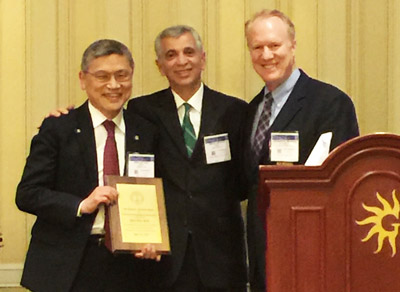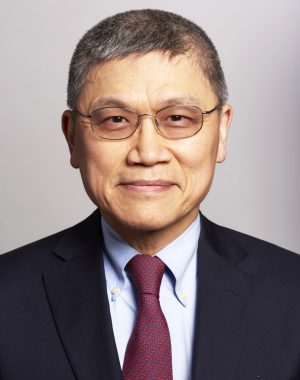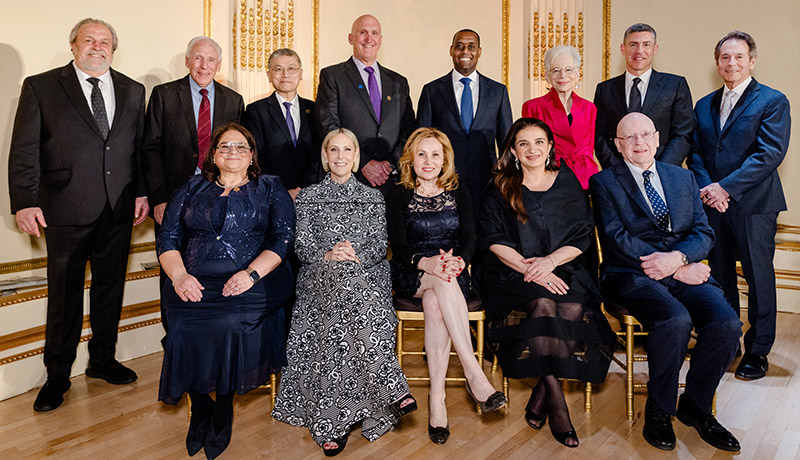Introduction
I want to express my gratitude to NATS for the honor of doing this interview. I have been a member of the New York Singing Teachers Association for more than 20 years and have had the pleasure of associating with many of its members. As a voice care professional in New York City, it has been my privilege and pleasure to care for many singers from all genres. I hope some of the comments I make below can help during voice development or a minor crisis.
What would you consider your career’s main focus or your “specialty”?
The main focus of my career is the development of laryngology as a subspecialty within the field of otolaryngology. As you may or may not be aware, otolaryngology requires five years of additional residency training after completing the medical degree. A subspecialty in laryngology specializing in voice and swallow disorders is recent. Only within the last 20 years have we had a fellowship training program in laryngology. As someone interested in the larynx, I needed to focus my practice and energies independently before there was a laryngology fellowship. Although I am not fellowship-trained, I have focused my practice and academic interest in the area of laryngology since the completion of my residency.
How did you discover your calling for your specialty?
I remember the very first time I looked at the vocal folds in vibration as a 3rd-year medical student with Dr. Stuart Strong. My first view of the vocal fold in motion happened in 1977! You can imagine what a surprise and revelation that was. We never studied that in medical school! My readings from that exposure led me to discover that the first person to look at the vocal folds was no other than Manuel Garcia, a well-known singing teacher who has published many papers on how to sing! We, as otolaryngologists, came to look at vocal fold vibration only during the latter half of the 20th Century.
When I finished my otolaryngology residency, the field of laryngology was in its infancy, and the routine observation of vocal folds in vibration was rare. I saw an opportunity to make a significant impact, so I focused my academic interest on this pioneering specialty.
How did it start?
In 1983, I had the good fortune to start in Syracuse, New York, with a group of like-minded physicians, PhDs, and singing teachers.
We established the first voice clinic in the late 1980s, a significant milestone in laryngology. At that time, we were all tenured people paid to research! The team was the first clinical voice clinic in the country. This multidisciplinary team consisted of Dr. David Brewer, MD; Dr. Raymond Colton, PhD; and Dr. Jeanina Casper, PhD. Eventually, we hired a research coordinator and a singer to join our team.
In those days, seeing just six patients for an entire afternoon was not uncommon. Each patient would be referred for a slot to see four or five different clinicians for 45 minutes each. Each one of the clinicians had a different job. My job was to perform the videostroboscopy. Dr. David Brewer’s job was to perform the fiberoptic laryngoscopy. Dr. Raymond Colton’s job was to obtain acoustic and aerodynamic measures. Dr. Jeanine Casper was a speech pathologist who did therapeutic probes. We also had singing teachers from the local Tri-City opera system join our team.
At the end of this grueling session, the patients were required to stay at the end of the day so that we, as a team, could come together and have a multidisciplinary conference similar to that of a cleft palate clinic. We would present our data during the conference and synthesize the problem. This interdisciplinary conference was a testament to our collaborative approach, allowing us to give a recommendation based on the group’s information on the case. This meeting was an excellent multidisciplinary approach to voice problems; we were all part of it. Little did we know that this was quite revolutionary for the time.
As a team, we attended the Voice Foundation meetings from the 1980s, and that was what I remember one of the most collegial, social, and academic gatherings at the beginning of my career.
What do you love the most about your work?
I really enjoyed that, as a clinician, I can continue to provide unique insights on the voice and voice production that I have gathered throughout my career, and help patients with voice disorders and swallowing disorders. Not a single day goes by where I have not made a difference.
In your opinion, what qualities do you feel make an “excellent” Vocal Pedagogue?
Having worked with many vocal pedagogues in my career, the field is constantly evolving. The qualities that I have found most prized are curiosity and an open mind. One prized trait is a curiosity to be not satisfied with the dogma that has been passed along. Curiosity is critical in exploring new approaches to pedagogy. An open mind is needed to explore new techniques to facilitate voice production in young and established singers. Although it is essential to have therapeutic authority to work with singers, it is also important to be humble enough to know that one does not know everything and that ongoing training and retraining are necessary to become outstanding in one’s field.
Can you speak to the importance of having mentors?
The importance of having a lifelong Mentor cannot be overstressed. Early on, as an academic faculty, it was essential to have a mentor, Dr. Brewer, to take me to the Voice Foundation meetings and introduce me to his colleagues. At that time, I was surprised that he engaged me to be on panels and other activities at the Voice Foundation. During mid-career, a mentor is vital. Often, career decisions are made, such as academic research versus clinical focus. Not only is it necessary to have mentorship, but it is also essential to be associated with colleagues of like minds within your specialty. That way, during meetings and other non-formal gatherings, people can bounce ideas off each other. We have fostered that feeling through the American Laryngological Association by having a candidate group and a mentor-mentee program established for laryngologists and young clinicians.
How have mentors influenced your life/career?
Research and clinical science mentors have helped me direct my area of interest. For example, in his early career, Dr. Colton was among the first to use the Rothenberg mask to measure subglottic pressure and flow. Using this device was his research interest, but that interest prompted me to look at it. Vibratory physiology and quantification of vocal fold vibration interested me. This interest resulted in my Triological thesis on quantifying vocal fold vibratory patterns. Since then, additional interest in understanding vocal physiology has prompted us to use high-speed video to study vocal fold vibration in voice production and vocal pathology. All this started because of the simple need to understand what another PhD was talking about.
Can you tell us about some of your mentors?
Some of the lifelong mentors I have had the privilege to associate with have been in academia. Dr. Stan Shapshay, who is now retired, has been a lifelong Mentor since residency. He was also my chairman for a few years when I was a faculty at Tufts University. During our 40+ years of Association, he has always been willing to talk shop and advise me on academic pathways to achieve my goals. In addition, he was instrumental in getting me on the various committees of the national societies so that I could move forward in my academic career, including being the president of the various national organizations in otolaryngology.
Another clinical mentor has been Dr. Hugh Biller. He was an outstanding clinician who taught me a way of thinking about the larynx and the surgical possibilities. I still think about how he would think about a clinical problem.
Dr. Stuart Strong and Dr. Charles Vaughn were my other mentors when I was a resident. Dr. Strong was the department chairman, always asking the residents, “Why are you doing that?” On the other hand, Dr. Charlie Vaughn always asked the residents, ” Why are you not doing that?” From these two people, I learned to ask the question why and why not.
When it comes to breathing, what are the most influential tips, insights, or research findings that you would like to share with our audience?
I learned much about breathing from watching Phyllis Curtin in her master class seminar in 1994 and 1995 over two years. I was very fortunate to audit her master’s class for two years, one afternoon per week during the academic year. She taught me the importance of respiration and imagery to this day. I can appreciate that singing is not just about sound production at the throat.
Regarding the larynx, what are the most influential tips, insights, or research findings that you would like to share with our audience?
The most amazing organ of the larynx continues to be an area of fascination for search on phonation production. The importance of interaction in breathing, oscillation source, and resonance continues to be an area of interest. Initially, we were primarily interested in vocal fold oscillation. We appreciate that vocal folds do not participate in vibration in isolation and that the entire system must be part of the integrated approach to understanding voice production.
Regarding the vocal folds, what are the most influential tips, insights, or research findings that you would like to share with our audience?
The most essential component of understanding vocal fold oscillation is that vocal folds cannot oscillate without lubrication. From many years of observation and research, it is very clear that our understanding of mucosal hygiene is only at the beginning. Understanding the viscoelastic properties of the vocal fold cannot be understood by just the physical aspects of vibration. It must be done clinically using experimental models such as drugs, environmental changes, and therapeutic probes. This research must be coupled with advanced state-of-the-art instrumentation such as high-speed video, phonatory airflow analysis, and even high flow and anemometry.
When it comes to acoustics/resonance, what are the most influential tips, insights, or research findings that you would like to share with our audience?
I have always been impressed that singers with damaged vocal folds can still sing well. This points to the fact that years of singing have developed compensatory capabilities using acoustics and resonance that allow them to continue even when the primary source generator is not working to full capacity. More research must be done in this arena.
When it comes to vocal health, what are the most influential tips, insights, or research findings that you would like to share with our audience?
A good understanding of a singer’s vocal health is critical to a long-lasting career. Almost all my well-established singers will have good days and bad days related to their vocal health. As voice professionals, they will have learned how to manipulate their instrument and the singing characteristics to be able to go on. That said, vocal health and injury avoidance are critical to a long career. Allergies, acid reflux, laryngitis, and phonotrauma are the big three that contribute to poor vocal health. Inflammation will produce thick mucus, a sense of swelling, and an inability to phonate at a very low phonatory threshold. Therefore, understanding your risk factors related to health and vocal exposure is critical to a long career.
When it comes to style, what are the most influential tips, insights, or research findings that you would like to share with our audience?
During the pandemic, we have seen many singers switch between different styles. Many of these are necessary in order to continue to be gainfully employed. We have seen classical singers switch to rap, as well as Broadway singers switch to cruise-line singing. Therefore, it would be erroneous for me to believe that a classical singer should stay a classical singer. However, it does not come with major knowledge and adjustment in singing. For that, I will leave that to better-educated vocal pedagogues.
When it comes to posture, what are the most influential tips, insights, or research findings that you would like to share with our audience?
Only by attending many years of Voice Foundation workshops and other voice seminars devoted to professional voice have I learned the importance of posture, alignment, and kinesiology. As I see singers with muscle tension dysphonia and neck pain, I am increasingly referring these patients for osteopathic manipulation, physical therapy, and mind-body work.
Final Thoughts (Words of Wisdom, Books, Resources)?
If you are reading this, you must be one of the special people interested in expanding your horizons in voice care. The field, especially in voice production for singers, is ready for better clinicians and scientists. When I met with Jeanette Lovetri more than 25 years ago in New York to explore professional development programs for the New York Singing Teacher Association, I clarified that professional certification is not the first but the final goal. At the beginning, what is clear and necessary is a desire for a sense of excellence based on science and art history. Therefore, further development of a cadre of like-minded individuals is critical in developing the field of voice science in singing. I encouraged all of you in reading to form an organization of like-minded individuals with a charter to advance the science and clinical care of singing teachers through your organization. This could be through a singing science interest group, or it could be through a subcommittee of NATS. Have regular meetings based on science with curious and open-minded people. If you do this consistently, your world will flourish.
 Dr. Woo received the Guest of Honor, Recognition of Outstanding Contribution to the Art and Science of Laryngology and the The James Newcomb Award, Recognition of Outstanding Contribution to the Art and Science of Laryngology and Dedication to the The American Laryngological Association, April 2018.
Dr. Woo received the Guest of Honor, Recognition of Outstanding Contribution to the Art and Science of Laryngology and the The James Newcomb Award, Recognition of Outstanding Contribution to the Art and Science of Laryngology and Dedication to the The American Laryngological Association, April 2018.
 YouTube Channel
YouTube Channel


